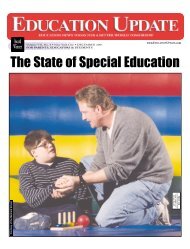Download PDF - Education Update
Download PDF - Education Update
Download PDF - Education Update
Create successful ePaper yourself
Turn your PDF publications into a flip-book with our unique Google optimized e-Paper software.
8 Special <strong>Education</strong> ■ EDUCATION UPDATE ■ NOV/DEC 2010Exclusive Interview with Dr. Harold Koplewicz, CEO, Child Mind InstituteTranscribed by Marissa SchainIs your child Dyslexicor experiencing school failure?If so, we may be the solution.We strive to help childrennot only have the skills neededto learn, but want to learn.TheSterlingSchoolWe take our commitment seriouslyOrton Gillingham trained staffSmall classes withindividualized attention<strong>Education</strong> <strong>Update</strong> caught up with Dr. HaroldKoplewicz, president of the Child Mind Institute,to discuss the latest issues in children’s mentalhealth care and what makes the Institute anunusual center.Dr. Pola Rosen (PR): What is the mission ofThe Child Mind Institute?Dr. Harold Koplewicz (HK): We’re a relativelyyoung organization. We just celebrated ourfirst anniversary. We have a very big mission.Our mission is transform mental health care forthe world’s children to fulfill their full potential.In this country alone we have 50 million childrenwho have a real psychiatric disorder and less thanhalf of them get help. We want to change theway we deliver the care, how we identify thesekids who have these problems, and we want toimprove the treatments. We want to improve thetreatments that are out there and also find newtreatments so that kids can really do well at work,which is school, at love, which is most of the timewith their family, and at play which is hobbies orsports, or activities with their friends. What everyparent wants for their child is to have full lives.PR: How do you plan to do identification?HK: Diagnosis in child mental health is stillbeing done the old fashioned way, which istaking a history. In medicine, history taking isclearly the most important instrument we have.If you’re speaking to a man in his 50s who haspain in his chest that is radiating down his leftarm, you are concerned it might be some heartattack, some kind of myocardial infarction; themuscle of the heart is not getting the right bloodsupply. There are many ways we can test thehypothesis because we have instruments that cantake pictures of the heart. We have ways of lookinginside the heart. We are getting there with thebrain and what we are looking for is a new wayof making these diagnoses.We started the Healthy Grain Network. It’s theidea of taking 10,000 kids and putting them into afunctional MRI, which is different than a structuralMRI. It is an imaging machine that can tell youhow the brain is functioning. We have figured outthat if you let a child stay at rest, the brains ofkids who have ADHD [attention deficit hyperactivitydisorder], or have autism or have anxiety,the brain talks to itself differently than a typicalchild. When the brain is at rest, we can see someArt, music, culinary arts andcomputers for a rich educationNOW AcceptING ADmISSIONScall 718-625-3502WWW.SteRLINGScHOOL.cOmRuth Arberman,Director of the Sterling School299 Pacific Street, Brooklyn, New York 11201Watch the CompleteLive Video Interviewwith the Child MindInstitute CEO, Dr. HaroldKoplewicz online at<strong>Education</strong><strong>Update</strong>.comreal differences. If we can get thousands of kidsacross the world, to lie in a machine and get thesekinds of pictures, this would be the equivalent ofwhat the growth charts are like when you go toa pediatrician. We need to do that to the brain.Then we have to find a group of kids who havedisorders and see how their brain developmentis different in the development than typical kids.PR: Will this change the face of mentalhealth care?HK: This is truly going to be a game changerin many ways. We are trying to encourage ourscientists to break down asylums. Traditionallyyou would have a scientist at Columbia, orsomeone from Harvard who wouldn’t sharetheir data until they had published it. We want agroup of scientists who are part of our scientificresearch council from ten different institutionswith expertise from many different areas to beable to collaborate with each other and to be ableto put their data online even before they use it, sowe can speed up the process.In many ways child psychiatric disorders is thelast frontier. If you think about heart disease, 30years ago people, who had a heart attack, becamecardio cripples. If they survived they were neverthe same. Today with stents, with new medication,with bi-pass surgery, we can really changethe world.We haven’t been able to do that yet with psychiatry.We also know that 75 percent of seriouspsychiatric illness occurs before the age of 24, 50percent before the age of 14.The biggest bang for the buck that we can getis finding treatments that will work on kids early.PR: Will there be financial benefits for thenation if you treat symptoms and illness early?HK: I think truly while child psychiatric illnessis misunderstood; there are many myths aboutit. It doesn’t really make a difference what yourpolitical affiliation is. This is good for our nation.Whether you are a liberal who cares desperatelyabout the good of children’s lives, mentalhealth is good for our children. They’ll do betterin school, more likely to graduate, less likely todrop out and get involved in illegal activities.If you’re a fiscal conservative, it is good for us tofind more solutions for good mental health for ourkids. Because if you do stay in school and you dograduate your chances of paying taxes and becominga contributor to society are much greater thanif you find school so frustrating because you can’tsit still in school, or you’re too anxious to attend,and frankly becoming someone who takes fromsociety than someone who is able to contribute.PR: In re MRIs: Will that research andthose tools be able to tell us that a child hasADHD or has autistic tendencies? Will thoseMRI’s be able to differentiate between some ofthe diagnoses we have out there now?KH: The Holy Grail has always been the bloodtests. If you have a cough and you are hackingaway and it bothers you tremendously and you goto the doctor, before he even takes a chest x-ray,if you have a fever and a cough and he takes ablood test, we can tell whether or not you have avirus or a bacterial infection. If you have a virus,we can tell the patient, “drink plenty of fluids andstay in bed, you will live longer than the virus.” Ifit’s a bacterial infection, there are specific antibioticsyou can take and have to take to make sureit doesn’t get worse.You’re not going to be able to get that specificblood test. But what we will be able to get arebiomarkers. If we can be able to tell the differencebetween the brain of a child who is typicalversus the brain of a child with autism tendencieson the Asperger and Autism spectrum versus thebrain of a child with ADHD, that becomes theconfirmation of a diagnoses. That in itself wouldbe very reassuring for parents. One of the hardestthings that parents have is A) accepting their childhas one of these disorder and B) the treatment.Very rarely has there been more controversythan the idea of medication for psychiatric disorders.Instead of embracing them and saying thatwe have a wonderful group of medications thatcan help children sit and focus…many people inthe public think that’s cheating or that’s teachingchildren to use drugs. The facts on this are completelyagainst that. In fact they say we know thatkids that are adequately medicated for ADHDearly are less likely to use drugs later. Kids thatare properly medicated for depression are lesslikely to self-medicate later.The truth is that psychiatric illness in children isnot only common but it’s quite treatable and childrenwho have these disorders can go on to livenormal lives if they get the treatment they deserve.PR: Are you planning outreach programsin schools?HK: More importantly than local schools, likeWilly Sutton said, the reason he robbed banksis that’s where the money is, and the reason wework in schools, is simply that’s where the kidsare. Teachers know children better than anybodyelse. If you talk to a group of parents who havethree children, their sample size is three. If agood teacher has 25 kids in her class every yearof third grade and she has been teaching for tenyears, she knows 250 eight-year-olds; she’s goingto tell you a lot.More importantly today because of all thebudget cuts, many schools are eliminating specialeducation or exclusion programs so teachers morethan ever really have to have skills in classroombehavior and classroom management. And if theycan’t do that, they end up spending so much timeon the child who’s making the most amount ofnoise and the other kids end up suffering. Schoolis supposed to be a place of learning, not a placeof psychiatric treatment. Teachers have to havethese kinds of skills.We’re now working on a pilot program for Teachfor America. We’re working on a program with theBoard of <strong>Education</strong> here in New York City to seeif we can establish programs that can be replicatedacross the nation. One of them, which I think ismost interesting, is a program called Parent ChildInteraction Therapy. We work with kids who aredisruptive and are off task. That program wasstarted by a group of people at the University ofFlorida. We are becoming the largest training site inPCIT. We train parents about what behaviors theyshould ignore, what behaviors they should actuallystop, and what behaviors they should praise. If yourkid is doing lots of things that you don’t like, whenthey do something that you do like, you tend notto praise it and you tend to ignore it and that’s notgood. And we train parents about these skills, weevaluate the child by observation, sometimes wego to school and observe then, and then we givethe parents a receiver they put in their ear. Eitherthrough a one-way mirror or through a camera, weare able to tell parents when they should ignorethings, what they should praise, and if they’re notpraising enough and to stop behavior that is reallydisruptive. It works fast in 6 to 10 sessions.Now we are transforming that teacher interactiontherapy. We ask them to take the most difficultchild they’re having difficulty managingout of the class and to work with that child infront of us. We give them skills to work with themost difficult child in praising them, in ignoringcertain behaviors and stopping certain behaviors,[and] they can generalize those skills for thewhole class.A good example of that would be if one childis constantly raising their hand and the other childrenin the class don’t raise their hand. If you concontinuedon page 9
















